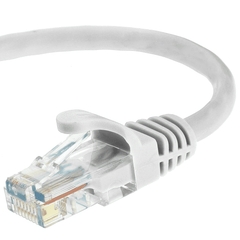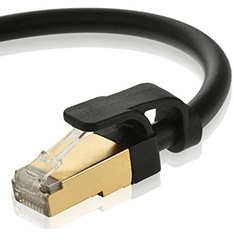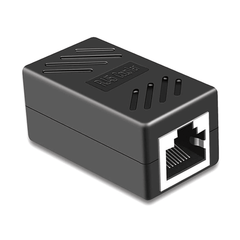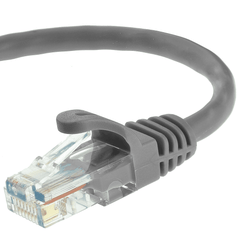Cat7A Ethernet Network Cable with RJ45 Connectors for LAN (Cat-7A)
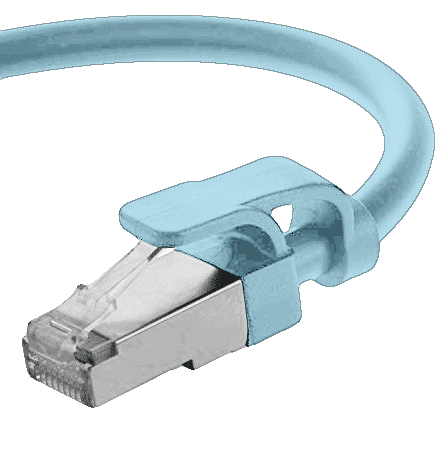
Cat7A Ethernet Network Cable with RJ45 Connectors for LAN (Cat-7A)
Buy Now, Pay Later with No Interest if paid in full within 6-12 months. Choose Klarna payment option at the checkout for details of this, and other long-term low-interest financing options.
Free Lifetime Support. SKU / Model: CAT7A-1FT
1(855)846-2654
Need installation quote, or help with designing a custom solution? Submit a request for quote.
- Description
- Reviews
- Questions & Answers
- Make An Offer
- Warning
Description
Product Description
CAT7A Cable for LAN is very high speed 10 Gigabit F-Type cable. CAT-7A Ethernet Network Cable with RJ45 Connectors consists of 4 twisted pair conductors. Category 7A cable with RJ-45 terminators has shielding for each twisted pair and an outside shielding (S/FTP). Category7A's additional jacket allows for higher bandwidth of up to 1000 MHz. Individual pairs are shielded with foil. These protect them from electromagnetic interference (EMI). This is crucial for electrically noisy environments such as server rooms or data centers. The cable's exterior braided shielding that wraps all 4 pairs, protect even more from EMI. The drain wire helps ground electricity after cable termination anywhere within the Local Area Network (LAN). See below for detailed illustration of this cable's composite:
Cat7a Cable Cross-Section Sketch:

Above Cat 7a cross section view shows conductor, insulation, drain wire, braid, Aluminum foil, rip cord and jacket.
General Network Cables Narrative.
CAT7 and CAT7a Ethernet Cabling.
Ever since its introduction in 2001, CAT5e (Category 5 enhanced) cabling has remained a popular ethernet cabling solution for LANs (local area networks) due to it being considered robust and cost-effective technology. Today, CAT5e is still widely used in small office and home office environments.
Newer CAT7 and CAT7a Ethernet Cables.
Ongoing advancements in technology have brought about the introduction of CAT7 and CAT7a ethernet cabling, which provide considerable unique benefits. The newest standards in interconnected technologies and ethernet cabling, Category 7 cabling has been developed under strict EMI protection and crosstalk specifications. Fully compliant with Class FA ISO 11801 requirements, CAT 7 cabling is also compliant with RoHS and REACH. The "A" in CAT-7A stands for, "Augmented", which has both shielding for each twisted pair and an overall shielding (S/FTP).
If you're wondering which type of ethernet cabling is the right choice for you, read on.
CAT7 and CAT7a Product Specifications.
Applications for CAT7 and CAT7a include HDBaseT, PoE+, and 10-gigabit ethernet. When tested to 600 megahertz (CAT7) and 1000 megahertz (CAT7a), these ethernet cables exhibit high levels of noise immunity. All pairs of cabling are shielded individually, allowing for the safe running of multiple applications on one cable. Both Category 7 and Category 7a Ethernet cables include four pairs of individually shielded cables, protecting signals from EMI and crosstalk. CAT7 and CAT7a ethernet cables are an effective copper solution over distances of 100 meters for ethernet at 10 gigabits.
While commonly measured with a GG45 connector, CAT-7 provides backward compatibility with RJ45 8p8c connectors commonly used in CAT5e and CAT6 ethernet cables. Originally developed by Nexans under IEC 60603-7-71, the GG45 is a connector with four conductors providing frequency support of up to 600 megahertz or as much as 1000 megahertz when using CAT7a. These greater frequencies allow for full 10-gigabit ethernet support.
Developed by Siemon, TERA connectors can be used to terminate CAT7 cabling. With a uniquely designed footprint, TERA connectors are not compatible with RJ45 8p8c standard connectors. TERA connectors provide full frequency support of up to 1000 megahertz for a CAT 7a cable and up to 600 megahertz for a CAT7 ethernet cable. With high-frequency support, CAT7 and CAT7a Ethernet cables can carry additional data and are better placed to allow ethernet applications on 10 gigabits.
Speed and Versatility.
CAT 7 is speed rated at 600 megahertz, while CAT7a is speed rated at 10 gigabits (1000 megahertz). Both Category7 and Category7a can maintain their data speeds over distances as long as 100 meters, representing speed gain potentially ten times that of CAT5e cabling, which is speed rated at 100 megahertz. If you're working over shorter distances, CAT7 may offer even greater benefits, with testing consistently showing CAT7 ethernet cabling performing even faster over short lengths. This may not directly apply to you due to the size of your installation, but it does outline the performance levels available and the suitability of CAT7 and CAT7a ethernet cabling in networks with high demand.
CAT7 and CAT7a ethernet cabling also offer additional benefits when it comes to signal stability. CAT5e has the designation Unshielded Twisted Pair (UTP), being composed of four sets of paired copper twisted wire. While this composition works well in some situations, it can cause problems with interference in other situations. On the other hand, CAT 7a has the designation Shielded, Foiled Twisted Pair (S/FTP). This means that each pair of copper twisted wire is foiled individually, and then all four pairs are coated in a further braided shield. As a result, attenuation of signal is drastically reduced, increasing protection from electromagnetic interference or crosstalk. This is the type of signal noise that can be generated by infrastructure equipment, air-conditioning, and fluorescent lights. An additional benefit of CAT-7 ethernet cabling is pair sharing, in which one CAT7 cable can be used to connect multiple devices.
Cost Considerations.
The cost to manufacture CAT7 and CAT7a ethernet cabling can be higher than the cost of manufacturing CAT5 cabling due to its complex construction, resulting in higher retail prices for consumers. Other factors that can contribute to the price differential between the different types of ethernet cabling include the stiffness of the cable (although this tends not to have much impact on the process of installation), the use of TERA connectors or CG45 (GigaGate45) connectors, and the need to ground the cabling.
When it comes to retail prices, however, the differences are typically not as much as may be expected. It should also be borne in mind that choosing CAT7 or CAT7a ethernet cabling introduces a level of future-proofing due to the associated higher network capacity.
Data Centre Applications.
Within a data center environment, CAT7 and CAT7a can be employed as backbone server connectors, allowing for high-speed interconnected data transfers throughout the network. A legitimate alternative to traditional fiber-optic cables, CAT7 and CAT7a Ethernet cables offer similar performance standards while being a less fragile cabling solution. Most importantly for installations on fixed budgets, CAT7 and CAT-7a Ethernet cables tend to be more cost-effective than equipment used to support fiber-optic cabling.
Comparisons with CAT5e and CAT6
Simply put, Category-7 and Category-7a ethernet cabling can support greater frequency signals when compared with CAT5e and CAT6 cabling, allowing for a much greater amount of data transfer. Additionally, CAT7 and CAT7a Ethernet cables provide greater levels of protection for the data whilst traveling through the cable. EMI and crosstalk effects are lessened due to the shielding and tighter twisting within the structure of CAT7 and CAT7a ethernet cabling.
CAT 7 is not currently widely adopted in some situations where CAT5e and CAT6 cabling provide an effective solution. For example, it is not necessary to use a CAT7 ethernet cable to connect to a desktop as the greater bandwidth allowances would not be utilized. For the same reasons, the newer CAT7 and CAT7a ethernet cabling may be considered an unnecessary additional expense for some data centers. However, as data and bandwidth requirements continue to increase alongside technological advancements, CAT7 and CAT7a will find their place in desktop connections and data centers.
Choosing the Right Ethernet Cabling for You.
In many installations, CAT5e ethernet cabling will still be a valid choice - particularly with networks that are changed frequently, in small-sized offices, or when a change of premises is anticipated. CAT7 and CAT7a ethernet cables, however, are considered the best solution for installations with high bandwidth, or in situations where increased demand is expected. It is worth noting that many smart home designs are now using CAT7 and CAT7a as standard ethernet cabling.
Contact Us for Personalised Advice.
It is always difficult to make generalizations since there are differences between every type of ethernet installation. If you are unsure about the best type of ethernet cabling to suit your installation, feel free to contact the friendly team at SignalBooster.com, who will be happy to provide obligation-free advice on the right typ e of cabling for you.We can look at your individual circumstances, go through the benefits of CAT5e, CAT7, and CAT7a cabling, and take your budget considerations into account. Trust us, we're Local Area Network (LAN) experts, too. Our industrial grade Cel-Fi QUATRA signal enhancement systems use these network cables and we have made great effort to understand everything about them so we can help you make the right decision.
Specifications of this Cat7a cable:
| ||||||||||||||||||||||||||||||||||||||||||||||||||||||||||||||||||||||||||||||||||||||||||||||||||||||||||||||||||||||||||||||||||||||||||||||||||||||||||||||||||||||||||||||||||||||||||||||||||||||||||||||||||||||||||||||||||||||||||||||||||||||||||||||||||||||||||||||||||||||||||||||||||||||||||||||||||||||||||||||||||||||||||||||||||||||||||||||||||||||||||||||||||||||||||||||||||||||||||||||||||||||||||||||||||||||||||||||||||||||||||||||||||||||||||||||||||||||||||||||||||||||||||||||||||||||||||||||||||||||||||||||||||||||||||||||||||||||||||||||||||||||||||||||||||||||||||||||||||||||||||||||||||||||||||||||||||||||||||||||||||||||
Reviews
Questions & Answers
QUESTIONS & ANSWERS
Have a Question?
Be the first to ask a question about this.
Data Sheet / User Guide
Make An Offer
Warning
Note: For any signal booster to help, outside signal strength must be at least -110 dB or there must be a clear line of sight to a cell tower that is within twenty miles. Before ordering, please check outside signal level in decibels or ensure that you can make and hold a phone call at any good spot outside where you can mount an exterior antenna. Square footage stated in signal booster listings is based on good signal outside. If it is any weaker, the boosted sq. ft. area will be considerably lower, accordingly.
Kevin K. of Anderson, California gave the following review:
Website is easy to use with plain straight forward info but could have had more on testing signal strength to make sure you get a strong enough booster.
Therefore, please note that stated sq. ft. coverage is based on good signal outside. For best results: If outside signal is weak, we suggest choosing the next higher sq. ft. coverage kit. If outside signal is very weak, we suggest choosing the kit with even more higher sq. ft. range bracket. Basically, higher the sq. ft. bracket, the more powerful the signal amplifier with greater Gain as well as higher uplink and downlink output power.
If outside signal is too weak (weaker than -110 dB), submit request for cell coverage solution assessment. Upon receipt of questionnaire, we will perform residential or business site survey. This will help us determine the system that is needed to improve cell coverage. Then, we will create system design using that system such as femtocell, active or hybrid distributed antenna system (DAS), or other carrier feed signal enhancing method available that will work at your signal-challenged location. Finally, we will schedule for installation after equipment and installation service quote has been approved by you, or your company.
For non installation-included kits: Most home / office / building cell signal booster kits only include bracket to mount exterior antenna on outside wall, edge of roof, or existing pipe up to 2 inches in diameter. Mounting pole not included with most kits, unless stated specifically that it is included for free. Therefore, a mounting post must be purchased separately if you will require it to mount exterior antenna.

Related Products




